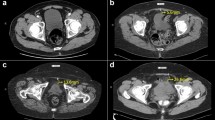Abstract
Purpose
Hydronephrosis is a frequently observed but understudied complication in patients with cervical cancer. To better characterize hydronephrosis in cervical cancer patients, the current study sought (1) to describe hydronephrosis-associated morbidity and (2) to analyze the prognostic effect of hydronephrosis in patients with a broad range of cancer stages over time.
Methods
The Mayo Clinic Tumor Registry was interrogated for all invasive cervical cancer patients seen at the Mayo Clinic from 2008 through 2013 in Rochester, Minnesota; these patients’ medical records were then reviewed in detail.
Results
Two hundred seventy-nine cervical cancer patients with a median age of 49 years and a range of cancer stages were included. Sixty-five patients (23 %) were diagnosed with hydronephrosis at some point during their disease course. In univariate analyses, hydronephrosis was associated with advanced cancer stage (p < 0.0001), squamous histology (p = 0.0079), and nonsurgical cancer treatment (p = 0.0039). In multivariate analyses, stage and tumor histology were associated with hydronephrosis. All but one patient underwent stent placement or urinary diversion; hydronephrosis-related morbidity included pain, urinary tract infections, nausea and vomiting, renal failure, and urinary tract bleeding. In landmark univariate survival analyses, hydronephrosis was associated with worse survival at all time points. In landmark multivariate analyses (adjusted for patient age, stage, cancer treatment, and tumor histology), hydronephrosis was associated with a trend toward worse survival over time (hazard ratios ranged from 1.47 to 4.69).
Conclusion
Hydronephrosis in cervical cancer patients is associated with notable morbidity. It is also associated with trends toward worse survival—even if it occurs after the original cancer diagnosis.
Similar content being viewed by others
References
Rose PG, Shamshad A, Whitney CW et al (2010) Impact of hydronephrosis on outcome of stage IIIB cervical cancer patients with disease limited to the pelvis, treated with radiation and courrent chemotherapy: a Gynecological Oncology Group study. Gynecol Oncol 117:270–275
Chao KSC, Leung W, Grigsby PW et al (1998) The clinical implications of hydronephrosis and the level of ureteral obstruction in stage IIIB cervical cancer. Int J Radiat Oncol Biol Phys 40:1095–1100
Pradham TS, Duan H, Katsoulakis E et al (2011) Hydronephrosis as a prognostic indicator of survival in advanced cervix cancer. Int J Gynecol Cancer 21:1091–1096
Wit EMK, Horenblas W (2014) Urological complications after treatment of cervical cancer. Nat Rev Urol 11:110–117
Atuhairwe S, Busingye RB, Sekikubo M, Nakimuli A, Mutyaba T (2011) Urologic complications among women with advanced cervical cancer at a tertiary referral hospital in Uganda. Int J Gynecol Obstet 115:282–284
Hazewinkel MH, Gietelink L, ven der Velden J et al (2012) Renal ultrasound to detect hydronephrosis: a need for routine imaging after radical hysterectomy? Gynecol Oncol 124:83–86
Paick SH, Oh SY, Kim HH (2003) The natural history of hydronephrosis after radical hysterectomy with no interoperatively recognizable injury to the ureter: a prospective study. BJU Int 92:748–750
Morris M, Eifel PJ, Grisby PW et al (1999) Pelvic radiation with concurrent chemotherapy compared with pelvic and para-aortic radiation for high-risk cervical cancer. N Engl J Med 340:137–143
Lapitan MC, Buckley BS (2011) Impact of palliative urinary diversion by percutaneous nephrostomy drainage and ureteral stenting among patients with advanced cervical cancer and obstructive uropathy: a prospective cohort. J Obstet Gynaecol Res 37:1061–1070
Suprasert P, Euathrongchit J, Suryachai P et al (2009) Hydronephrosis after radical hysterectomy: a prospective study. Asian Pac J Cancer Prev 10:375–378
Funding
This work was funded by 5K24CA131099.
Author information
Authors and Affiliations
Corresponding author
Rights and permissions
About this article
Cite this article
Patel, K., Foster, N.R., Kumar, A. et al. Hydronephrosis in patients with cervical cancer: an assessment of morbidity and survival. Support Care Cancer 23, 1303–1309 (2015). https://doi.org/10.1007/s00520-014-2482-y
Received:
Accepted:
Published:
Issue Date:
DOI: https://doi.org/10.1007/s00520-014-2482-y




